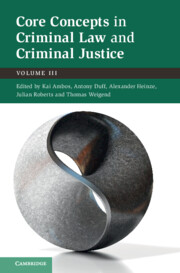Book contents
- Core Concepts in Criminal Law and Criminal Justice
- Core Concepts in Criminal Law and Criminal Justice
- Copyright page
- Contents
- About the Authors
- Abbreviations
- 1 Introduction to Volume III
- Part I Criminal Law
- Part II Criminal Procedure
- Part III Criminal Justice
- 10 Sentencing Procedure
- 11 Confiscation and Forfeiture of Property in Connection with Alleged Unlawful Conduct
- Index
- References
11 - Confiscation and Forfeiture of Property in Connection with Alleged Unlawful Conduct
A Preliminary Assessment of Risks and Process
from Part III - Criminal Justice
Published online by Cambridge University Press: 09 July 2025
- Core Concepts in Criminal Law and Criminal Justice
- Core Concepts in Criminal Law and Criminal Justice
- Copyright page
- Contents
- About the Authors
- Abbreviations
- 1 Introduction to Volume III
- Part I Criminal Law
- Part II Criminal Procedure
- Part III Criminal Justice
- 10 Sentencing Procedure
- 11 Confiscation and Forfeiture of Property in Connection with Alleged Unlawful Conduct
- Index
- References
Summary
This chapter focuses on the practices of confiscation and forfeiture, by which the government permanently transfers money or property from the individual to the state, without compensation, because of a connection between the property and alleged unlawful conduct. The chapter describes and critically considers the rules on both conviction-based confiscation and forfeiture and those allowed without obtaining a conviction in six jurisdictions in Europe (the European Union, Finland, Germany, Norway, Sweden, England & Wales) and relatively common practices at the federal and state levels in the United States. The chapter describes and examines several of the purported benefits and costs of these practices as well as key issues related to adjudicatory processes and statutory and constitutional protections. In doing so, the chapter identifies a number of fundamental areas of concern, offering some suggested avenues for reform or further study.
Keywords
Information
- Type
- Chapter
- Information
- Core Concepts in Criminal Law and Criminal JusticeVolume III, pp. 395 - 437Publisher: Cambridge University PressPrint publication year: 2025
References
Accessibility standard: WCAG 2.1 AA
Why this information is here
This section outlines the accessibility features of this content - including support for screen readers, full keyboard navigation and high-contrast display options. This may not be relevant for you.Accessibility Information
Content Navigation
Allows you to navigate directly to chapters, sections, or non‐text items through a linked table of contents, reducing the need for extensive scrolling.
Provides an interactive index, letting you go straight to where a term or subject appears in the text without manual searching.
Reading Order & Textual Equivalents
You will encounter all content (including footnotes, captions, etc.) in a clear, sequential flow, making it easier to follow with assistive tools like screen readers.
You get concise descriptions (for images, charts, or media clips), ensuring you do not miss crucial information when visual or audio elements are not accessible.
Visual Accessibility
You will still understand key ideas or prompts without relying solely on colour, which is especially helpful if you have colour vision deficiencies.
Structural and Technical Features
You gain clarity from ARIA (Accessible Rich Internet Applications) roles and attributes, as they help assistive technologies interpret how each part of the content functions.
